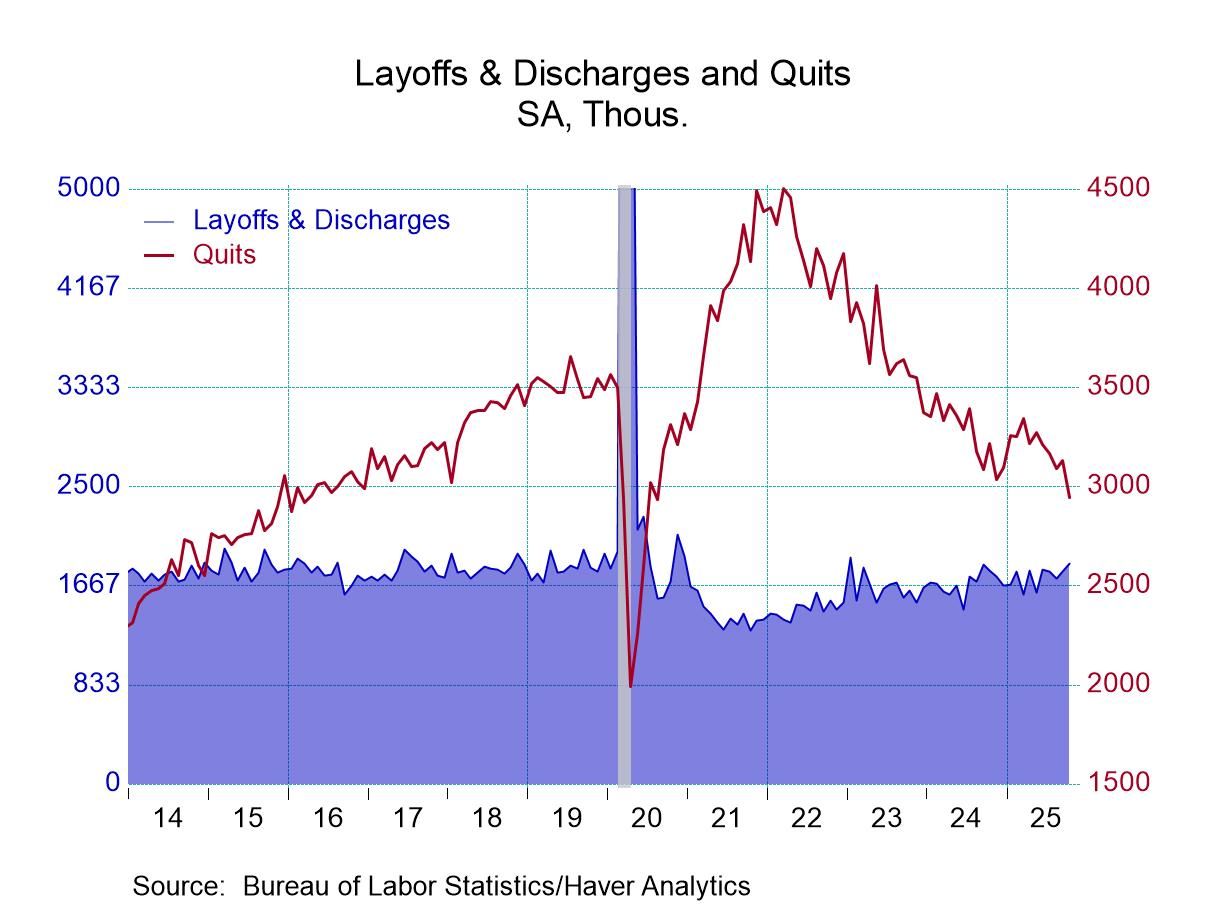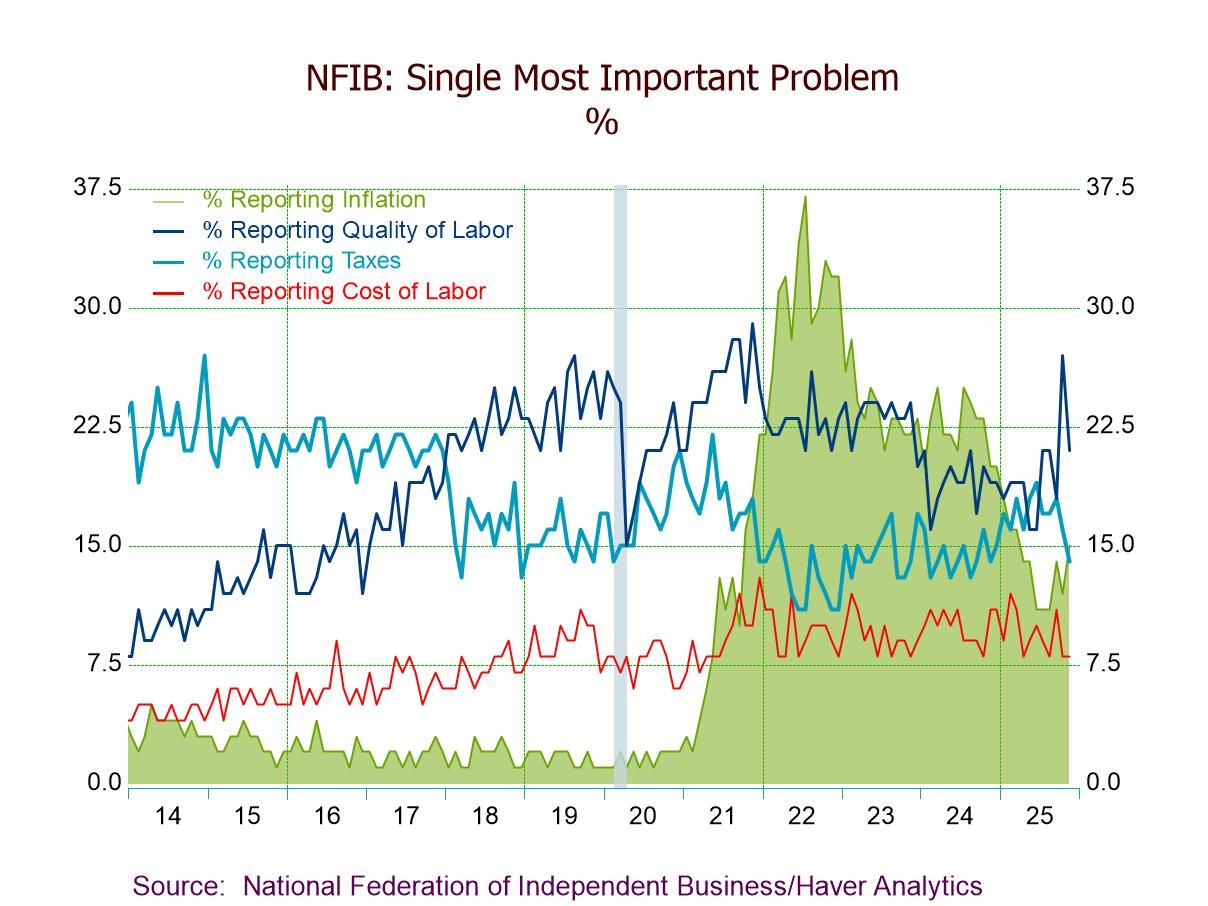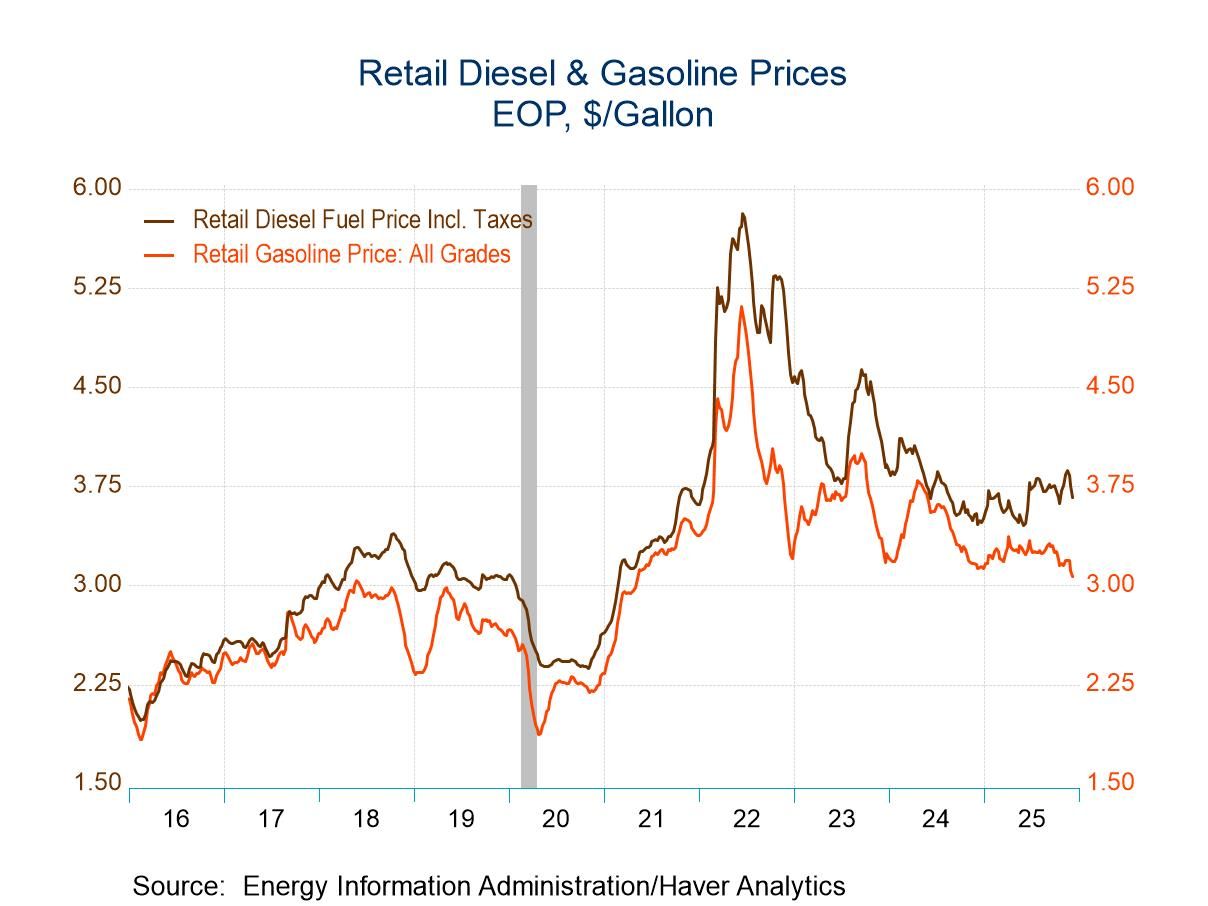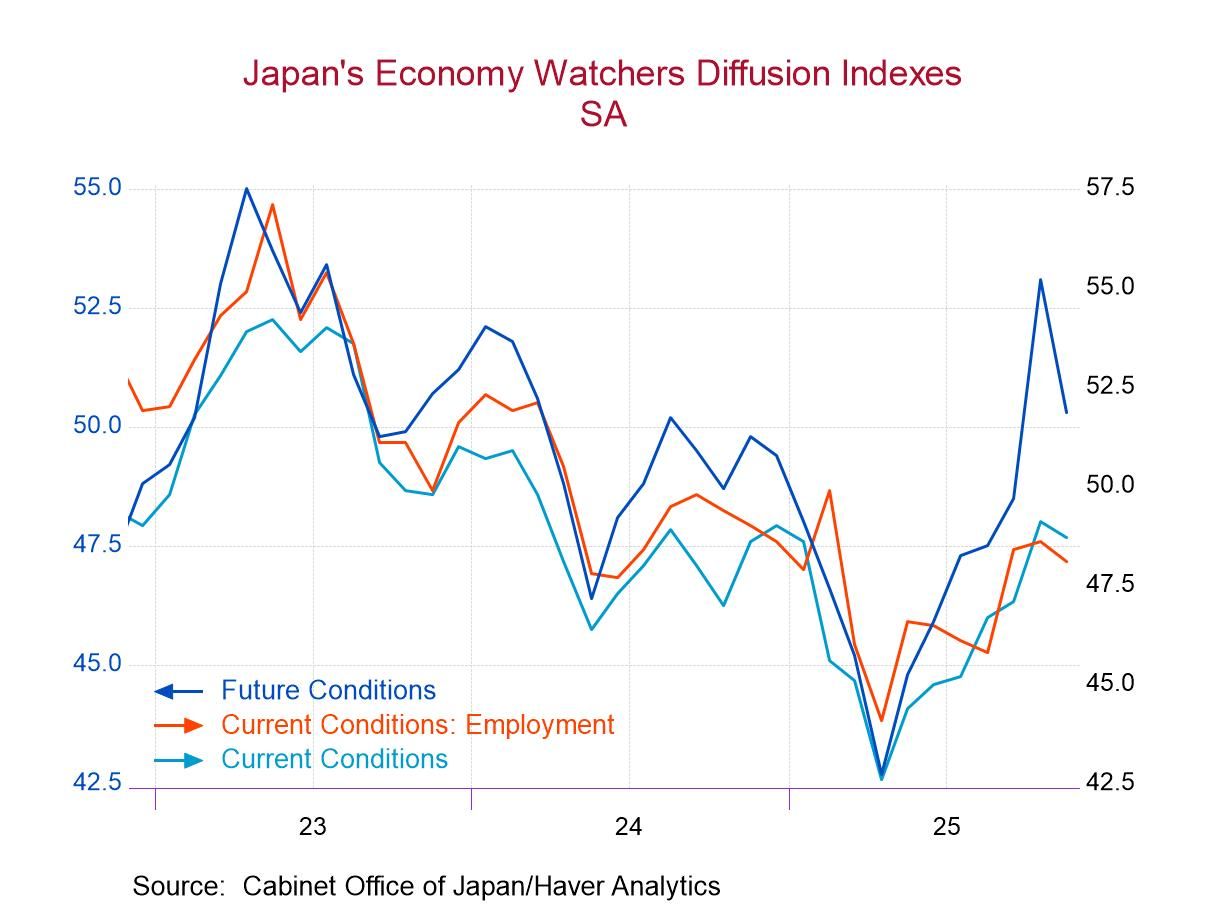 Global| Dec 17 2014
Global| Dec 17 2014U.S. Consumer Prices Post Largest Decline Since 2008; Core Prices Moderate
by:Tom Moeller
|in:Economy in Brief
Summary
Inflationary pressures remain well contained. The consumer price index fell 0.3% during November (+1.3% y/y) following unrevised stability during October. It was the largest monthly decline since December 2008 and outpaced [...]
Inflationary pressures remain well contained. The consumer price index fell 0.3% during November (+1.3% y/y) following unrevised stability during October. It was the largest monthly decline since December 2008 and outpaced expectations for a 0.1% dip in the Action Economics Forecast Survey. A 3.8% energy price decline (-4.9% y/y) led the CPI lower. Prices excluding food & energy ticked up an expected 0.1% (1.7% y/y) after a 0.2% rise.
Energy prices were pulled lower by a 6.6% drop in gasoline prices (-10.5% y/y). Prices have fallen 14.3% during the last five months. Fuel oil prices declined 3.5% (-10.1% y/y) while natural gas prices eased 1.7% (+3.2% y/y), the sixth decline in the last seven months. Electricity costs ticked 0.1% higher (2.8% y/y). A 0.2% rise in food prices (3.2% y/y) offset part of this downward pressure. Egg prices gained 1.1% (6.2% y/y) while meat prices rose 0.3% (12.8% y/y). To the downside, fruit & vegetable prices moved 0.7% lower (+1.6% y/y) and dairy prices eased 0.2% (+5.0% y/y).
Prices for goods excluding food & energy declined 0.4%, pulled down by a 1.3% drop in appliance costs (-4.9% y/y) and a 1.1% decline in apparel prices (-0.4% y/y). Also falling were recreation goods prices by 0.6% (-2.8% y/y) and new vehicle prices, off 0.1% (+0.6% y/y). These declines were countered by a 0.6% rise in medical care goods prices (3.1 y/y) and a 0.1% uptick in furniture & bedding prices (-2.2% y/y).
Continuing to firm were services prices by 0.2%. The gain was paced by a 1.1% rise in public transportation prices (-2.4% y/y) and a 0.4% increase in tuition costs (3.3% y/y). Medical care prices also gained 0.4% (2.3% y/y). Rents of primary residence costs increased 0.3% (3.5% y/y) and owners equivalent rent of primary residence costs rose 0.2% (2.7% y/y). Recreation prices slipped marginally (+1.2% y/y).
The consumer price data is available in Haver's USECON database while detailed figures can be found in CPIDATA. The expectations figure is from Action Economics and is found in the AS1REPNA database.
| Consumer Price Index (%) | Nov | Oct | Sep | Nov Y/Y | 2013 | 2012 | 2011 |
|---|---|---|---|---|---|---|---|
| Total | -0.3 | 0.0 | 0.1 | 1.3 | 1.5 | 2.1 | 3.2 |
| Total less Food & Energy | 0.1 | 0.2 | 0.1 | 1.7 | 1.8 | 2.1 | 1.7 |
| Goods less Food & Energy | -0.4 | 0.0 | 0.0 | -0.5 | -0.0 | 1.3 | 1.3 |
| Services less Energy | 0.2 | 0.3 | 0.2 | 2.5 | 2.4 | 2.4 | 1.8 |
| Food | 0.2 | 0.1 | 0.3 | 3.2 | 1.4 | 2.6 | 3.7 |
| Energy | -3.8 | -1.9 | -0.7 | -4.9 | -0.7 | 0.9 | 15.2 |
U.S. Current Account Deficit Deepens Slightly
by Tom Moeller December 17, 2014
The U.S. current account deficit deepened in Q3'14 to $100.3 billion from $98.4 billion in Q2. The deficit shrank to 2.3% of GDP from 5.8% in 2006. The Action Economics Forecast Survey called for a Q3 deficit of $95.0 billion. Exports of goods, services and income slipped 0.3% (+4.0% y/y), while imports were little-changed (3.5% y/y).
The Q3 deficit on merchandise trade shrank to $182.1 billion but remained in the range of the last two years. Goods exports rose 1.3% (4.0% y/y) and imports of goods slipped 0.3% (+3.5% y/y).
The trade surplus on services dipped to $57.7 billion but remained just off its record. Services exports were unchanged (3.0% y/y). Travel exports edged 0.5% higher (3.1% y/y) but financial services exports fell 2.6% (+6.6% y/y). Imports of services gained 0.3% (3.6% y/y), as travel imports edged up 0.3% (8.2% y/y) and financial services were little-changed (4.9% y/y).
The surplus on primary income improved to a near-record $59.0 billion as receipts from abroad grew 2.3% (6.8% y/y) and payments to foreigners ticked up just 0.3% (4.0% y/y). The trade deficit on secondary income deteriorated to $34.9 billion.
From the financial account, private direct investment abroad of $93.7 billion was accompanied by $153.4 in portfolio investments. Direct investments from abroad totaled $65.4 billion and portfolio investments were $250.9 billion.
Balance of Payments data are in Haver's USINT database, with summaries available in USECON. The expectations figure is in the AS1REPNA database.
| US Balance of Payments SA | Q3'14 | Q2'14 | Q1'14 | Y/Y | 2013 | 2012 | 2011 |
|---|---|---|---|---|---|---|---|
| Current Account Balance ($ Billion) | -100.3 | -98.4 | -102.1 | -101.3 | -400.3 | -460.8 | -459.3 |
| Deficit % of GDP | -2.3 | -2.3 | -2.4 | -2.4% | -2.4% | -2.9% | -3.0% |
| Balance on Goods ($ Billion) | -182.1 | -189.3 | -182.3 | -177.9 | -701.7 | -742.1 | -740.6 |
| Exports | 1.3% | 2.3% | -1.9% | 4.0% | 2.0% | 4.2% | 16.2% |
| Imports | -0.3% | 2.8% | 1.0% | 3.5% | -0.4% | 2.9% | 15.5% |
| Balance on Services ($ Billion) | 57.7 | 58.1 | 57.8 | 3.0 | 225.3 | 204.5 | 192.0 |
| Exports | 0.0% | 1.8% | 0.0% | 3.0% | 5.0% | 4.3% | 11.4% |
| Imports | 0.3% | 2.5% | -0.9% | 3.6% | 2.6% | 3.4% | 6.5% |
| Balance on Primary Income ($ Billion) | 59.0 | 54.8 | 52.4 | 51.5 | 199.7 | 203.0 | 221.0 |
| Balance on Secondary Income ($ Billion) | -34.9 | -22.0 | -30.0 | -31.6 | -123.5 | -126.1 | -131.7 |
U.S. Mortgage Loan Applications Decline; Interest Rates Little-Changed
by Tom Moeller December 10, 2014
The Mortgage Bankers Association reported that their total Mortgage Market Volume Index fell 3.3% last week (-3.9% y/y). Applications to purchase a home fell 6.9% (-5.3% y/y) but applications to refinance were little changed (-3.0% y/y).
The effective interest rate on a 15-year mortgage of 3.40% has been little-changed since late October. The effective rate on a 30-year fixed rate loan edged down slightly to 4.12%. The rate on a Jumbo 30-year loan slipped to 4.07%. For adjustable 5-year mortgages, the effective interest rate of 3.16% was stable w/w and remained down versus last year's 3.74% peak.
The average mortgage loan size slipped to $252,200. For home purchases, it rose to $278,100; for refinancings, it slipped to $239,000.
Applications for fixed interest rate loans declined 2.1% y/y while adjustable rate loan applications fell 24.6% y/y.
The survey covers over 75 percent of all U.S. retail residential mortgage applications, and has been conducted weekly since 1990. Respondents include mortgage bankers, commercial banks and thrifts. The base period and value for all indexes is March 16, 1990=100. The figures for weekly mortgage applications and interest rates are available in Haver's SURVEYW database.
| MBA Mortgage Applications (SA, 3/16/90=100) | 12/12/14 | 12/05/14 | 11/28/14 | Y/Y % | 2013 | 2012 | 2011 |
|---|---|---|---|---|---|---|---|
| Total Market Index | 360.0 | 372.3 | 347.0 | -3.9 | 616.6 | 813.8 | 572.3 |
| Purchase | 165.5 | 177.7 | 175.5 | -5.3 | 197.5 | 187.8 | 182.6 |
| Refinancing | 1,518.9 | 1,518.7 | 1,341.1 | -3.0 | 3,070.0 | 4,505.0 | 2,858.4 |
| 15-Year Mortgage Effective Interest Rate (%) | 3.40 | 3.43 | 3.36 | 3.78 (12/13) |
3.42 | 3.25 | 3.97 |
FOMC Indicates Patience Toward Raising Rates
by Tom Moeller December 17, 2014 At today's meeting of the Federal Open Market Committee, the Fed indicated, "Based on its current assessment (of the economy), the Committee judges that it can be patient in beginning to normalize the stance of monetary policy." The Fed also indicated that despite improvement, "economic conditions may, for some time, warrant keeping the target federal funds rate below levels the Committee views as normal in the longer run."
Several indicators of economic improvement were noted including "solid" job gains and a lower unemployment rate. Consumer spending and business investment were seen to have risen moderately. The housing recovery, however, was judged to be slow.
Lower energy prices were seen as holding the overall inflation rate down. The Fed also indicated that "longer-term inflation expectations have remained stable."
The press release for today's FOMC meeting can be found http://www.federalreserve.gov/newsevents/press/monetary/20141217a.htm.
The backdrop to today's meeting was slower M2 growth of 6.0% y/y and little growth in the monetary base.
Haver's SURVEYS database contains the economic projections from the Federal Reserve Board.
| Current | Last | 2013 | 2012 | 2011 | 2010 | |
|---|---|---|---|---|---|---|
| Federal Funds Rate, % (Target) | 0.00-0.25 | 0.00-0.25 | 0.11 | 0.14 | 0.10 | 0.17 |
| Discount Rate, % | 0.75 | 0.75 | 0.75 | 0.75 | 0.75 | 0.72 |
Tom Moeller
AuthorMore in Author Profile »Prior to joining Haver Analytics in 2000, Mr. Moeller worked as the Economist at Chancellor Capital Management from 1985 to 1999. There, he developed comprehensive economic forecasts and interpreted economic data for equity and fixed income portfolio managers. Also at Chancellor, Mr. Moeller worked as an equity analyst and was responsible for researching and rating companies in the economically sensitive automobile and housing industries for investment in Chancellor’s equity portfolio. Prior to joining Chancellor, Mr. Moeller was an Economist at Citibank from 1979 to 1984. He also analyzed pricing behavior in the metals industry for the Council on Wage and Price Stability in Washington, D.C. In 1999, Mr. Moeller received the award for most accurate forecast from the Forecasters' Club of New York. From 1990 to 1992 he was President of the New York Association for Business Economists. Mr. Moeller earned an M.B.A. in Finance from Fordham University, where he graduated in 1987. He holds a Bachelor of Arts in Economics from George Washington University.






